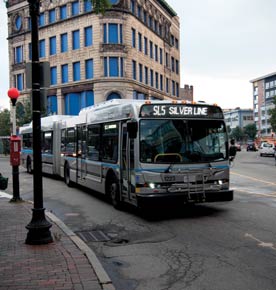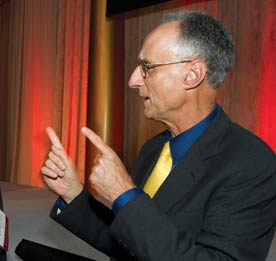
Green roof, which reduces heating and cooling costs and stormwater runoff, on an affordable multifamily project constructed by AHC Inc. Photo courtesy of AHC Inc.
Nine years ago the Virginia Housing Development Authority (VHDA), Virginia’s housing finance agency, became concerned about the construction quality, attractiveness, and durability of the state’s tax credit developments. Seeing in emerging green building practices the kind of longevity and quality they were looking for, VHDA began awarding points for adopting green building standards as part of the state’s competition for Low Income Housing Tax Credits.
Initially, points were awarded for including such items as high efficiency heat pumps and Energy Star¨ windows and appliances. In 2006, VHDA ratcheted up the process and began to stipulate tax credit projects had to be green-certified by EarthCraft Virginia, a third-party, nonprofit organization.
The incentives have worked. “Affordable housing developers are going full speed ahead bringing green building to scale all over Virginia,” says Jessica Abralind, Arlington County green building specialist.
Philip Agee, green building technical manager for EarthCraft Virginia, agrees. “By incentivizing green building, VHDA has really revolutionized multifamily housing, especially affordable projects, in Virginia.”
Good Economic Sense
Sustainable building makes sense for the affordable housing industry. “We plan to own and operate our affordable communities for years to come,” says Walter D. Webdale, president and CEO of AHC Inc., a nonprofit affordable housing developer based in Arlington, Virginia. “Investing in green building not only pays off for us by reducing operating costs, but it also provides more healthy living environments for our residents and helps reduce their expenses as well. Plus, building green helps us be good neighbors and community leaders.”
AHC Inc. is not alone. Of the 75 multifamily projects EarthCraft has under construction, 68 are affordable. “It makes sense that affordable housing developers, who plan to own their project for a long time, are interested in durability and investing more upfront in design and construction costs to save more over the long term,” says Agee. “Durability and maintenance costs — a lot of those decisions are being guided by green building. The affordable housing industry was tuned into this before many market-rate developers.”
Still, affordable housing developers have to take a pragmatic approach to adding green features. “We are very sensitive to the costs of our projects,” says Curtis Adams, AHC project manager. “We pick and choose what green features are prudent for the project. Everyone wants to build green; it’s just a matter of what we can buy with our dollar.”
Carefully used, that dollar goes a long way though. AHC has found that the cost of creating its EarthCraft-certified buildings has generally only accounted for about a 2 to 3 percent increase in upfront construction costs; Earthcraft notes that a recent market rate-development it certified only increased its costs by 1.7 percent to qualify. Some other certification programs, such as the U.S. Green Building Council’s LEED Gold or above, can be much more expensive. “It’s a balancing act,” says Adams. “AHC, like the entire industry, is on a learning curve to find the best cost/benefit combination for each project.”
Savings Through Efficiency
Some of the primary green features affordable housing developers employ are cutting-edge heating and cooling systems and water saving initiatives.
For instance, the Macedonian, a 36-unit building in Arlington, has, along with a tight envelope and low-emissivity windows, a “variable fluid flow” heating and cooling system — a system used largely in Europe and Asia that achieves much higher efficiency than typical heat pumps. Up to nine units operate off of one condenser, which means that when one tenant is using heat at the same time as another is using air conditioning (often seen in the spring and fall), the waste heat from the air conditioning will be redirected to the units needing heat. The system costs more upfront, but it will last longer and run more efficiently.
“The Macedonian is the most energy efficient multifamily building we’ve done in Northern Virginia, with some of the best integrated design we’ve seen in the state,” says Agee. EarthCraft estimates that The Macedonian will use 40 percent less energy than a similar project built to code.
Installing low-flow faucets, fixtures, and toilets can also generate substantial savings over time. AHC estimates that replacing existing fixtures and toilets with new water-efficient ones can save around 11,000 gallons per apartment or at least $120 a year (based on current Arlington County water and sewer rates).
Market-rate developers and investors are beginning to catch on to these benefits of sustainable building. EarthCraft is increasingly working with market-rate developers and their investors. “There are private funders out there that are only willing to invest in sustainable or green projects,” says Agee.
Initial Reluctance
Some developers were wary at the outset about the benefits of green building. Some were concerned that EarthCraft’s onsite requirement for inspections and approvals would slow the construction process itself. However, they soon learned that EarthCraft’s involvement did not create the types of delays they had feared.
Concerns about the increased cost of green building were also relieved as developers began to see that the additional years of life in a building as a result of new standards was a wise investment on many levels. Energy Star¨ and lower environmental impact products tend last longer. They are “higher quality” all around, and less energy use results in less wear and tear on many parts of the building. For example, efficient lights last longer, windows are thicker/more dense and therefore less prone to break, and when HVAC ducts are more efficient, systems need to work less to heat and cool.
In addition, those developers who covered the cost of utilities in their projects quickly saw the savings that were produced with a more secure building envelope. Virginia’s experience has shown that the certification program is helping low-income residents reduce their utility costs, and, as Chandler says, “VHDA is happy to encourage that.”
Opportunities for Innovation in Green Building
Overtime, affordable housing developers have become more innovative and creative with green features. For instance, The Macedonian is the first affordable multifamily project with a green roof that EarthCraft has helped develop. “The heavy carpet of vegetation not only looks beautiful, but it also moderates the overall building temperature by protecting the roof from summer heat and retaining warmth in the winter,” says Adams. “The roof has also been structured to retain storm water that is absorbed by the plants.”
This year, EarthCraft Virginia has already helped design two zero-energy affordable apartment buildings with cutting edge solar systems, which could give residents an opportunity to pay absolutely no utilities. Designed to be 70 to 80 percent more efficient than similar apartments built to code, the units’ remaining energy use is covered with energy generation via solar thermal and photovoltaic solar panels.
Because there continues to be intense competition for the credits — a 3:1 ratio of applications to available credits — each year VHDA adds more teeth to its point categories for tax credits by adding or enhancing the green requirements. This year, VHDA suggested developers set energy goals before submitting applications — before budget and design constraints — which is resulting in even more energy efficient designs.
The U.S. Department of Energy has issued a builder’s challenge that new residential construction be energy-neutral by 2030; in Virginia, it looks like affordable housing will lead the way there.




Comments